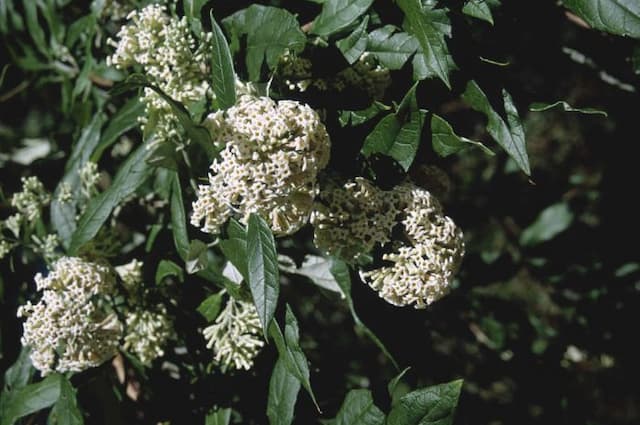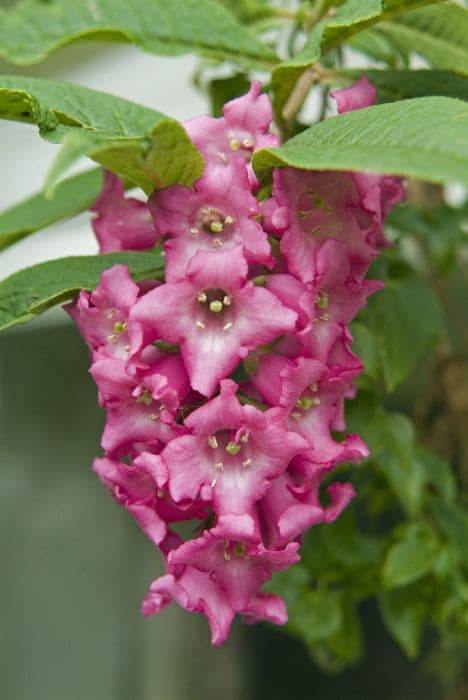Butterfly Bush Buddleja × weyeriana 'Bicolor'

ABOUT
The plant known as Buddleja 'Bicolor' is a stunning multi-colored flowering shrub. Its appearance is marked by an array of vibrant flowers, which present a captivating mix of colors, mainly in shades of soft purple and orange. These blossoms typically take the shape of small, tubular structures, often clustered together to form conical flower spikes that can add a striking visual interest to any garden setting. The foliage of 'Bicolor' is equally attractive, with leaves that are lance-shaped and feature a pleasing green hue. These leaves provide a lush backdrop for the colorful flowers, enhancing the overall beauty of the shrub. The leaves' texture and arrangement contribute to the plant's ornamental value, creating a full and bushy appearance that is visually appealing throughout the growing season. The stems of the plant are sturdy and may have a slightly arching habit, which supports the weight of the flower clusters and contributes to the plant's aesthetic shape and form. The contrast between the flowers and the foliage, along with the plant's structure, makes it a favorite among gardeners seeking to introduce a burst of color and vibrancy to their outdoor spaces.
About this plant
 Names
NamesFamily
Scrophulariaceae
Synonyms
Bicolor Butterfly Bush, Harlequin Butterfly Bush
Common names
Buddleia x weyeriana 'Bicolor', Buddleja x weyeriana 'Bicolor'.
 Toxicity
ToxicityTo humans
Butterfly Bush (Buddleja × weyeriana 'Bicolor') is generally not considered toxic to humans. There is no well-documented evidence of serious toxicity associated with this plant in humans. Nonetheless, as with any plant, individual allergies or sensitivities may occur, and it is generally not advisable to ingest parts of ornamental plants. If ingestion occurs and symptoms appear, it is recommended to consult a healthcare provider.
To pets
Butterfly Bush (Buddleja × weyeriana 'Bicolor') is also not known to be toxic to pets. It does not appear on common lists of plants that are poisonous to dogs and cats. However, ingestion of non-food items, including various parts of plants, can cause gastrointestinal upset in pets such as vomiting and diarrhea. If your pet displays symptoms or behaves unusually after consuming any part of the plant, it is advisable to contact a veterinarian.
 Characteristics
CharacteristicsLife cycle
Perennials
Foliage type
Deciduous
Color of leaves
Green
Flower color
Mixed
Height
5-6 feet (1.5-1.8 meters)
Spread
5-6 feet (1.5-1.8 meters)
Plant type
Shrub
Hardiness zones
5-9
Native area
Cultivar - no precise native area
Benefits
 General Benefits
General Benefits- Attracts Pollinators: The flowers of the Butterfly Bush are known to attract butterflies, bees, and other pollinating insects, which are essential for the ecosystem.
- Low Maintenance: This plant requires minimal care once established, making it ideal for gardeners of all skill levels.
- Drought Tolerance: After establishment, the Butterfly Bush shows a strong tolerance to drought, reducing the need for frequent watering.
- Fast Growth: It is a fast-growing plant that can quickly fill in garden spaces with vibrant color and foliage.
- Long Blooming: The Butterfly Bush provides a long season of blooms, often from early summer until frost, offering a long-lasting display.
- Landscape Ornamentation: With its bicolor flowers, the plant is visually striking and can serve as a focal point in a garden design.
- Deer Resistance: Typically, Butterfly Bush is not a preferred plant for deer, which can help prevent damage to the garden from grazing.
- Versatile Use: The plant can be used in a variety of garden settings including borders, as a stand-alone specimen, or in butterfly gardens.
- Erosion Control: The quick growth and substantial root system can help stabilize soil and prevent erosion on slopes.
 Medical Properties
Medical PropertiesThis plant is not used for medical purposes.
 Air-purifying Qualities
Air-purifying QualitiesThis plant is not specifically known for air purifying qualities.
 Other Uses
Other Uses- Photography Backdrop: Due to its striking blooms, Buddleja 'Bicolor' can be used as an attractive natural backdrop for garden photography.
- Teaching Tool: Botany educators might use Buddleja 'Bicolor' to demonstrate plant growth, pollination, and hybridization concepts to students.
- Eco-Friendly Confetti: Dried petals of the Buddleja 'Bicolor' can be used as biodegradable confetti for outdoor celebrations to reduce environmental impact.
- Natural Dye: The blooms of Buddleja 'Bicolor' can be boiled to extract natural dyes for coloring textiles or crafts in shades of purple or lilac.
- Artistic Inspiration: Artists might be drawn to Buddleja 'Bicolor' for its vibrant color and form, inspiring paintings, drawings, or textile patterns.
- Floral Arrangements: Buddleja 'Bicolor' branches can be cut and integrated into floral displays, adding an exotic and colorful touch to bouquets.
- Garden Themed Crafts: Leaves and flowers from Buddleja 'Bicolor' can be pressed and used in creating garden-themed scrapbooks or greeting cards.
- Moth Attractor for Observation: As Buddleja 'Bicolor' is attractive to moths, enthusiasts can use the plant in their garden to observe and learn about local moth species.
- Privacy Screening: When planted in a row, Buddleja 'Bicolor' can create a semi-evergreen screen that provides privacy and aesthetic appeal.
- Potpourri Ingredient: Dried flowers from Buddleja 'Bicolor' can be used to craft homemade potpourri blends, offering a pleasant fragrance for the home.
Interesting Facts
 Feng Shui
Feng ShuiThe Butterfly Bush is not used in Feng Shui practice.
 Zodiac Sign Compitability
Zodiac Sign CompitabilityThe Butterfly Bush is not used in astrology practice.
 Plant Symbolism
Plant Symbolism- Transformation: As a cultivar of butterfly bush, Buddleja × weyeriana 'Bicolor' is associated with transformation due to its ability to attract butterflies, which are symbols of change and metamorphosis.
- Attraction: The plant's ability to attract a variety of pollinators, including butterflies and bees, symbolizes attraction and the power to draw in positive influences.
- Rebirth: Flowering year after year, the butterfly bush represents rebirth and the cyclical nature of life, providing a reminder of continual growth and renewal.
- Beauty: With its striking bicolor flowers, Buddleja × weyeriana 'Bicolor', like other ornamental plants, is often associated with beauty and the appreciation of aesthetic pleasures.
- Healing: Some cultures associate the butterfly bush with healing due to its medicinal properties and its role in supporting the lifecycle of butterflies, which themselves can symbolize recovery and healing.
 Water
WaterThe Butterfly Bush, often known by its botanical name Buddleja × weyeriana 'Bicolor', should be watered deeply to ensure the root zone is thoroughly moistened, especially during the warmer months. Ideally, it should receive about 1 to 1.5 inches of water per week, either from rainfall or manual watering. During the peak summer heat, you may need to water the Butterfly Bush twice a week, while in cooler temperatures or overcast weather, watering once every 7 to 10 days might suffice. Always check the top few inches of soil for moisture before watering; if the soil feels dry, it's time to water. Avoid overhead watering to reduce the risk of leaf diseases and focus on the base of the plant, using roughly 5 gallons of water each time for a mature shrub.
 Light
LightThe Butterfly Bush thrives in full sun conditions, requiring at least 6 to 8 hours of direct sunlight each day. The ideal spot for the Butterfly Bush is an area that is free from shade and has ample morning light, which helps to dry dew from the leaves, minimizing the risk of fungal diseases. Avoid planting in heavily shaded areas, which can result in reduced flowering and a leggy growth habit.
 Temperature
TemperatureThe Butterfly Bush is hardy and can tolerate a wide range of temperatures, but generally prefers a climate with temperatures ranging from 60 to 85 degrees Fahrenheit for optimal growth. It can survive minimum winter temperatures down to around -20 degrees Fahrenheit, but young plants may require some protection. The ideal temperature conditions are moderate, avoiding extreme heat or cold which can stress the plant.
 Pruning
PruningPruning the Butterfly Bush promotes healthier growth and more prolific blooming. Prune in late winter or early spring before new growth begins, removing any dead or damaged branches. This plant benefits from a hard prune, cutting back one-third to one-half of the previous year's growth. Prune annually to maintain the desired shape and size, and to encourage blooms, since the Butterfly Bush flowers on new wood. The best time for pruning is after the last frost and before the onset of the growing season.
 Cleaning
CleaningAs needed
 Soil
SoilButterfly Bush 'Bicolor' thrives in well-drained soil with a pH between 6.0 and 7.0. The best soil mix can be a combination of garden soil, peat or compost, and sharp sand or perlite to enhance drainage. It's important to avoid waterlogged conditions as this can lead to root rot.
 Repotting
RepottingThe Butterfly Bush 'Bicolor' typically doesn't require frequent repotting as it is often grown outdoors. If planted in a container, repot every 2-3 years or when the plant outgrows its pot to refresh the soil and provide additional space for root growth.
 Humidity & Misting
Humidity & MistingButterfly Bush 'Bicolor' is tolerant of a range of humidity levels and does well in the typical outdoor atmosphere. It does not have specific humidity requirements, making it quite adaptable to various outdoor environments.
 Suitable locations
Suitable locationsIndoor
Provide full sun, well-draining soil, and ample space to grow.
Outdoor
Ensure full sun, well-draining soil, and protect from harsh winds.
Hardiness zone
5-9 USDA
 Life cycle
Life cycleBuddleja 'Bicolor', commonly known as Butterfly Bush, begins its life as a seed, which, when sown in well-draining soil and given adequate warmth and moisture, will germinate to produce small seedlings. These seedlings develop into young plants with characteristic lanceolate leaves and begin to form a woody stem over time, a stage that can take several months. As the plant matures, it enters a rapid growth phase, typically reaching its full size within a few years, with stems that can grow several feet each year. In mid to late summer, Buddleja 'Bicolor' reaches the flowering stage, where it produces long, conical clusters of fragrant, bicolored flowers that attract butterflies and other pollinators. After pollination, the flowers give way to small capsules containing seeds, thus completing the reproductive cycle. During winter, the plant may die back especially in colder climates, but it is capable of regenerating from the root system or from surviving stems in the spring.
 Propogation
PropogationPropogation time
Spring-Early Summer
The Buddleia 'Bicolor', also known as the Butterfly Bush for its ability to attract butterflies, can be most effectively propagated through semi-hardwood cuttings. This method is typically done in late summer. Cuttings should be taken from the current year's growth, ideally from shoots that are beginning to turn woody but are not yet fully mature. These cuttings, which should be about 4 to 6 inches long (10 to 15 centimeters), must include several sets of leaves, and the lower leaves should be removed. The cut end of the cutting is dipped in rooting hormone to encourage root growth and then inserted into a mixture of perlite and peat. The cuttings should then be kept in a warm, humid environment with indirect light until roots have developed, which usually takes several weeks. Once rooted, they can be potted in individual containers.

![Butterfly bush [Berries and Cream]](/_next/image?url=https%3A%2F%2Fplants-admin.emdemapps.com%2Fimages%2Fplants%2F%2Fimages%2F604b650f667be.png&w=640&q=75)





![Butterfly bush [Nanho Purple]](/_next/image?url=https%3A%2F%2Fplants-admin.emdemapps.com%2Fimages%2Fplants%2F%2Fimages%2F604b5e3cb2c58.png&w=640&q=75)
